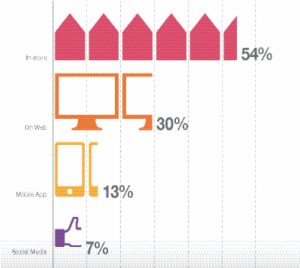Research company Forrester released predictions for this holiday season’s online sales to increase 15 percent over last year’s. Not surprising, but what does it mean for those of us who obsess over the store experience if more and more consumers are choosing to shop while sitting on a train or surfing Walmart.com while they are standing in a Target? How is this fluidity between digital and analog shopping changing shoppers’ habits? What do they want?
To find out, Fitch conducted a global study of 7000 shoppers in China, India, Brazil, Russia, the U.S., U.K. and U.A.E. The research explores what’s going on inside shoppers’ minds: their degree of involvement in shopping, levels of satisfaction, channel preferences and expectations for the shopping experience.
Here are some of the big findings:
• Shoppers in emerging markets, such as Brazil and India, are much more enthusiastic about shopping than those in mature markets, like the U.S. And, good news for retail designers everywhere, shoppers still prefer brick-and-mortar retail. Within several specific segments – grocery, fashion and electronics – shoppers showed a 98 percent, 84 percent and 64 percent preference respectively for the in-store experience over online/social shopping. With all the talk of showrooming that last number is somewhat unexpected. (Take note Best Buy!)
• But once consumers get into the store, their actual experiences are underwhelming. More than 50 percent of U.S. shoppers describe themselves as unhappy, indifferent and unimpressed. This experience gap is a big opportunity for retailers to step up their game.
Shoppers say they want to be inspired, learn something and have fun while they shop and they see a big gap on design basics that help them make the right choices. Eighty-nine percent of grocery shoppers, 74 percent of fashion apparel shoppers and 61 percent of electronics shoppers want stores to make it easier to find the products they want. This indicates that retailers can get shoppers back into the store by a renewed focus on Retail 101.
Advertisement
• What role will digital play? Demand for digital capabilities that help shoppers in-store and out will only grow, but tactics that don’t provide a real and immediate benefit for shoppers will be shunned. (When was the last time you zapped a QR code?) How these shiny, new touchpoints dovetail to create a positive brand experience in the store is the Holy Grail for retailers worldwide.
• No matter the channel, we believe that shoppers are moving between three universal mind states:
– Dreaming: seeking new ideas and inspiration
– Exploring: looking across a category with a specific item in mind
-Locating: searching for a specific item.
Keep in mind that the shopper can switch from one mind state to another in an instant. While the online onslaught will continue to take Locating shoppers away from stores, richer in-store experiences that engage all three mind states will allow brands and retailers to create a draw. Locating can still attract shoppers, but the goal is to ensure that they can tap into Dreaming and Exploring too. In fact, we found that the happiest shoppers are those who feel that their shopping experiences allow them to exercise all three mind states.
And happy shoppers mean happy retailers.
For more, including the four principles for navigating the new customer journey,
read the white paper here.
Stephen Jay is strategy director for Fitch North America. He’s been studying what consumers think about their store experiences for more than 15 years.
Advertisement


 Photo Gallery1 week ago
Photo Gallery1 week ago
 Headlines4 days ago
Headlines4 days ago
 Headlines1 week ago
Headlines1 week ago
 Headlines2 weeks ago
Headlines2 weeks ago
 Headlines1 week ago
Headlines1 week ago
 Designer Dozen1 week ago
Designer Dozen1 week ago
 Headlines1 week ago
Headlines1 week ago
 Headlines1 week ago
Headlines1 week ago
















